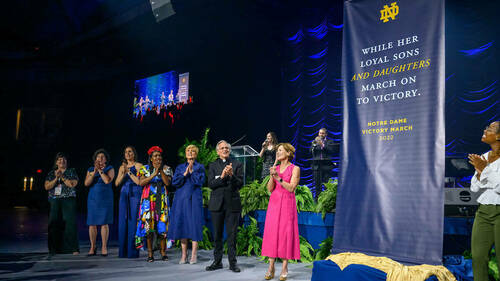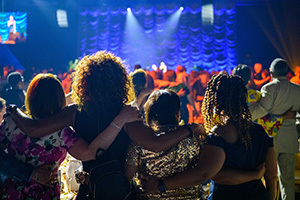
On the occasion of the 50th anniversary of the decision by then-President Rev. Theodore M. Hesburgh, C.S.C., to admit undergraduate women, the University of Notre Dame will re-imagine its Main Circle, the ceremonial entrance to campus, to commemorate this historic milestone, and will officially change the chorus of its renowned fight song to include both “sons and daughters,” announced University President Rev. John I. Jenkins, C.S.C., on Thursday (June 2) at the conclusion of a gala celebration of the anniversary at the Joyce Center.
The redesign of the Main Circle, to be completed in coming months, will honor the profound impact women have had on the University.
“The success Notre Dame enjoys has been shaped by the extraordinary leadership and contributions of the women who have been and are a part of the Notre Dame community — beginning with the four Holy Cross sisters who arrived in the Indiana wilderness in 1843, to those who lead, teach, learn, minister and work here today,” Father Jenkins said. “On this occasion of the anniversary of the admission of undergraduate women in 1972, we celebrate the invaluable contributions of women as students and graduates. The re-imaging of the Main Circle will be a tribute at the heart of our campus to the ways in which these women have inspired, led and enriched us.”
The 50th anniversary of the University’s decision to admit undergraduate women coincides with the 50th anniversary of the passage of Title IX of the Education Amendments of 1972, which prohibits sex-based discrimination in educational programs and activities.
“Notre Dame Victory March,” which has been rated America’s No. 1 college fight song, “will now specifically reference both the ‘sons and daughters’ of the University,” Father Jenkins said. Written by Rev. Michael Shea and his brother John in 1908, the Notre Dame Victory March includes the lines:
Cheer, cheer for old Notre Dame.
Wake up the echoes cheering her name.
Send a volley cheer on high.
Shake down the thunder from the sky.
What though the odds be great or small,
Old Notre Dame will win over all.
While her loyal sons are marching
Onward to victory.
Going forward, “Notre Dame Victory March” will be sung as follows:
While her loyal sons and daughters
March on to victory.

The first public performance of the newly arranged song took place after Father Jenkins’ announcement at the gala dinner.
Father Shea, a 1905 Notre Dame alumnus, wrote the music, and John, who earned Notre Dame degrees in 1906 and 1908, wrote the words. The song was copyrighted in 1908 and a piano version with the lyrics was published that year. The song’s public debut came in the winter of 1908 when Father Shea played it on the organ of the Second Congregational Church in Holyoke, Massachusetts. It was first performed on campus on Dec. 1, 1908. A decade later, the Notre Dame band began to perform the fight song at athletics events.
The Shea brothers thought their version of the song was “amateurish” and hoped someone would improve on it. In 1928, band director Joseph Casasanta did just that, arranging the song to sound as it is known today.
Northern Illinois University Professor William Studwell, in his book “College Fight Songs: An Annotated Anthology,” ranked “Notre Dame Victory March” as No. 1, followed by his personal favorite, the University of Michigan’s “The Victors.”
“‘Victory March’ is more borrowed, more famous and, frankly, you just hear it more,” Studwell said. “Anybody who says that Notre Dame’s isn’t one of the top five songs is out of his gourd. That’s like saying Shakespeare didn’t know how to write.”
The tune has, in fact, been borrowed by many American high school teams, a handful of Canadian schools and the Australian Football League team Sydney Swans.
“It’s probably the most recognized and performed of collegiate songs,” Kenneth Dye, director of bands and professor of music at Notre Dame, said. “Its inspirational rhythm and tempo create an energy that encourages fans to clap along and enjoy the music.”
Father Shea was the pastor of St. Augustine Church in Ossining, New York, until his death in 1938. John Shea, a baseball monogram winner at Notre Dame, became a Massachusetts state senator and lived in Holyoke until his death in 1965.